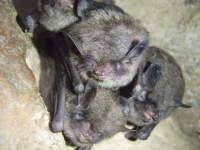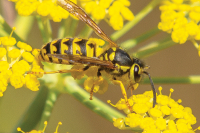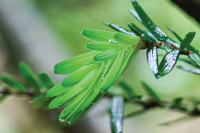Enthusiasts produce map with sampling of rides in Haywood
 You’ve got your chain well-oiled, air in your tires and water in your bottles. You are all set for a bicycle ride in Haywood County but haven’t the slightest idea where to go.
You’ve got your chain well-oiled, air in your tires and water in your bottles. You are all set for a bicycle ride in Haywood County but haven’t the slightest idea where to go.
To help lost tourists with bicycles mounted on their vehicles and locals who may not know the rural areas of the county, bicycle advocates and tourism promoters have teamed up to print a guide to six of Haywood’s best rides. For each route, the guide includes a map with an elevation profile, turn-by-turn directions, and a brief description on what riders should expect and the scenery they’ll encounter.
Blue Ridge Breakaway breaks path for bike culture
 By Paul Clark • Contributing writer
By Paul Clark • Contributing writer
Hundreds of bicyclists will soon be zipping along the scenic byways of Haywood County during the Blue Ridge Breakaway, challenging not only themselves but also the perception that cyclists and cars do not mix.
None of the four rides in the Breakaway is a race, but organizers hope that all of them will show Haywood County that cars and bikes don’t have to compete, said route director Cecil Yount. He was one of several people who contributed and presented to the Haywood County commissioners a comprehensive bicycle plan that links Canton, Clyde, Lake Junaluska, Maggie Valley and Waynesville.
Bicycle touring light Overnight trips take the pressure off planning, purchasing
 By Jack Moore • Contributor
By Jack Moore • Contributor
J.R.R. Tolkien wrote, “Not all those who wander are lost,” and he may as well have been writing about bicycle tourists. This time of year in the Smokies it’s not uncommon to see a cyclist, bike loaded with gear, struggling up and over one of our many mountain passes.
You might imagine they are on some grand adventure circumnavigating the globe or at least crossing the country in some epic voyage. You may be right, or it could be that this is one of your cycling neighbors out for a short overnight bicycle camping trip.
By foot or by bike: New running and cycling clubs hit their stride in Cherokee
Anyone can run or bike. And if any two people could testify to that, it’s Gerri Grady and Hugh Lambert.
Both Grady and Lambert have used exercise to overcome health problems. Now, both are leaders in two separate exercise- and social-centric clubs in Cherokee, aimed at promoting healthy lifestyles among members of the Eastern Band of Cherokee Indians.
Back in the 1990s, Grady, a founding member of the Cherokee Runners, could hardly walk, let alone run.
“I started walking because I was a heavy smoker,” said Grady, secretary of the running club. “God. I could barely walk.”
Following the death of her mother from asthma-related complications in the mid-1990s, Grady was determined to get fit and began strolling a 3-mile circuit a couple of times a week with her sister.
“I got scared because of that,” she said of her mother’s death.
Walking eventually gave way to running, and in 2001, Grady ran her first 5K and quit smoking. Now, she is a dedicated runner.
Like Grady, Lambert battled his own health problems — including sleep apnea and diabetes — before he took up cycling and started Cherokee Riders Cycling Club. Formerly 300 pounds, a now 205-pound Lambert has made strides to improve his overall health.
“There is no magic pill,” he said. “Take responsibility for your own health and actions.”
Lambert tried road cycling in college but did not keep it up. In the mid-90s, he tried again with mountain biking, but his carpel tunnel caused his hands to numb.
However, last year when Lambert heard about a Trail of Tears bike ride, things changed.
“I just had to do it,” he said.
Remember the Removal is an annual three-week bicycle ride commemorating the forced removal of the Cherokee Nation from its homelands during the 1830s - a brutal march where thousands of Cherokee perished from starvation and exposure. Riders retrace the route of the Trail of Tears through Georgia, Tennessee, Kentucky, Illinois, Missouri, Arkansas and finally to Oklahoma. The ride is exclusive, only seven or eight ECBI members can participate each year. The Cherokee Nation in Oklahoma also sends 10 cyclists to complete the ride.
Desiring to be one of those, Lambert bought a bike and began self-training last spring. He figured that if he could ride 6.5 miles from Cherokee to Waterrock Knob on the Blue Ridge Parkway, which climbs more than 3,000 feet in elevation, then he would be able to make the 950-mile trek to Oklahoma.
“It took me 3.5 hours to not make it half way,” said Lambert, who was impeded by some late winter snow.
But, two weeks later, he completed a similar length ride in Sylva and improved from there.
Club genesis
For years, Grady ran only with fellow enthusiasts from her family, but she continued to see other familiar faces along her running routes.
“I always saw the same people out on the trail,” Grady said.
When winter came, Grady moved inside to a local fitness center, and those familiar faces followed.
“And again, we are seeing all these people who have the same enjoyment,” she said.
However, it was not until spring 2009 when Grady and some of her family members went on vacation to Myrtle Beach that the idea of a running club initially arose. To gauge people’s interest, Grady sent out a Facebook message to her friends, many of whom also ran, advertising a meet-up and the possible formation of a running club.
“Oddly enough, here they came,” Grady said. “It’s just awesome.”
Cherokee Runners has grown from 15 to 40 members since its first meeting. And, as an official club, members have crossed the finish line in three marathons and countless half-marathons, 5Ks and 10Ks.
Members of the club meet regularly throughout the week with a longer run scheduled for Sundays. After a jaunt, the runners eat oranges and socialize while cooling down, Grady said.
“It’s not about competition so much as it is about health and fitness, and social (experiences),” she said, adding that anyone can join.
Taking a cue from the Cherokee Runners, Lambert decided to gather other cycling lovers and form the mountain and road biking club — Cherokee Riders.
“Mostly, we liked to ride, and we wanted to get other people involved,” he said.
Although it is not yet an official club, Cherokee Riders already has 10 members. It hopes to gain official club status, which includes crafting bylaws and membership applications, by the end of the month.
A main focus of the club is to raise money for Remember the Removal participants and help train them. The ride costs about $5,000 per person, as each is custom fitted with a bike.
This year, 22 people applied to be one of the seven who gets to represent the Eastern Band on the three-week ride.
During the ride, members of the national nonprofit Trail of Tears Association meet with the riders to give talks and programs during their overnight stops. Participants are “exposed to culturally significant places” along the way, he said. “Everybody who’s gone on the ride said it changed their life.”
Civically minded
As part of its mission statement, the Cherokee Runners participate in health fairs, training programs and hosts lectures. Speakers give a rundown of what to wear when exercising during the bone-chilling winter months and the sizzling summer months, how to deal with injuries, and training techniques. All of these outside activities are aimed at promoting exercise and fitness to residents of Cherokee.
“We try to be in the community, visible,” Grady said.
The club also sponsors runs and plans to hold a summer running camp for community members.
In the future, Grady and Lambert said they hope both clubs can work together toward their common goal — to get people to maintain a healthy lifestyle.
“They (the running club) are kind of a role model for community involvement,” Lambert said.
Once it’s more established, Cherokee Riders plans to offer bike safety courses, kids camps, training and, if the funds become available, a bike rental program.
Kick up your heels
The Cherokee Runners meets at 7 p.m. the first and 15th of every month in the Age Link building, behind the Yellowhill Community Club. However, if the meeting date falls on a church day, it is pushed back to the following day. Members also gather for runs throughout the week and go for a longer run every Sunday. To join in the weekly runs or for more information about the club, contact Gerri Grady at 828.497.7083 or This email address is being protected from spambots. You need JavaScript enabled to view it..
Get peddling
A new cycling club is forming in Cherokee. The Cherokee Riders will hold an organizational and interest meeting at 2 p.m. on Sunday, Feb. 12, at the Emergency Operations Center in Cherokee, followed by a group ride. The club will hold weekly group rides. For more information about the club or their rides, contact Hugh Lambert at 828.554.6810 or This email address is being protected from spambots. You need JavaScript enabled to view it..
Making Haywood more bike friendly
Haywood County is one step closer to getting a defined bike route traversing the county and improved cycling amenities.
The county commissioners approved a comprehensive countywide bicycle plan at its meeting Monday (Nov. 7). The plan aims to get more people on their bikes, whether for commuting or recreation, by making it safer and more convenient.
The proposal includes a central route that connects Waynesville, Lake Junaluska, Clyde and Canton.
Members of Bicycle Haywood N.C., the group spearheading the plan, have been making the rounds to town and county leaders looking for an endorsement of the plan. They have gone before every board so far except Canton.
The group was “met with outstanding responses,” said Cecil Yount, a member of Bicycle Haywood N.C.
A future path would also incorporate U.S. 276, U.S. 19, U.S. 23/74, Interstate 40 and N.C. 209, among others.
Overall, the total cost of the recommendations is between $64 million and $114 million — much of the estimated cost involves road projects that are already in the works.
Better accommodations for cyclists could be added to the road projects for “very little additional costs,” such as bike lanes and signage, said County Commissioner Chairman Mark Swanger.
No county funding will pay for the project, but the county may apply for grants, Swanger said.
The proposal is comprised of five E’s: education, encouragement, enforcement, engineering and evaluation.
Engineering would involve connecting a designated cross-county bike route to greenways, adding signage, repainting road marks and ensuring that intersections do not pose a safety threat to cyclists. A number of the recommendations include adding four- to six-foot wide shoulders along the side of the road.
“The good thing is that it gives you space to ride,” said Don Kostelec, a consultant hired to oversee the plan.
Education and encouragement include offering classes about bicycle safety and rules of the road, promoting healthy living and helping kids find safe bike routes to school. Enforcement simply means working with the police department, cyclists and drives to make the commute safer.
From 1997 to 2008, Haywood County reported 21 bicycle crashes; of those, 8 involved a person who was 17 years old or younger.
Once the plan begins, the committee will evaluate how many people use the bike route, participate in the classes and other cycling activities.
“I think it’s a quality of life issue,” said Swanger. “I think to have a safe place to ride is important.”
The path will also attract visitors to the region, stimulating the local economy.
According to a survey of a little more than 20 participants, the Blue Ridge Breakaway, an annual bike ride based in Haywood, the majority of respondents spent the night in Haywood County and stayed an average of 4.3 days, spending anywhere from $30 to $400 a day on accommodations.
There is no definitive timeline to complete the project, but Bicycle Haywood N.C. hopes to begin offering classes soon and would like to see towns add bicycle racks.
“This whole thing will take a while to do,” Swanger said.
The planning process began in April, and several public input meetings were held to get feedback about a possible route.
The idea got its start when members of the newly formed Bicycle Haywood N.C. decided last year that Haywood was lacking in formal communication among cyclists, county residents and local and governmental organizations, including the Department of Transportation and the Haywood County Recreation and Parks department.
The group of cycling enthusiasts received a $50,000 grant to develop the comprehensive plan — $40,000 of which came from the French Broad River Metropolitan Planning Organization. The organization is responsible for transportation planning in Buncombe, Haywood and Henderson counties. The Community Foundation of Western North Carolina, Mast General Store, the Blue Ridge Bicycle Club and members of Bicycle Haywood N.C. donated the remaining $10,000.
Survey says: we like bikes
This year, Bicycle Haywood N.C. surveyed county residents about what bicycle-related improvements they would like to see, and 151 people responded.
County residents would like to:
• Mark road shoulders as bike lanes: 75.7 percent
• Build off-road multi-use trails/greenways: 74.3 percent
• See more “share the road” signs: 56.6 percent
• Offer bike accommodations on bridges: 53.3 percent
• Have more bike racks: 36.8 percent
• Have wider sidewalks on bridges: 36.2 percent
• Post way-finding signs: 36.2 percent
• Incorporate an environmentally friendly design: 35.5 percent
More:
To see the comprehensive bike plan, including specific recommendations for making your community more bike-friendly, go to bicyclehaywoodnc.org/BikePlan.html.
Mud, Cowbells, and Beer: The Cyclocross Passions
For a good part of the past decade I have spent a lot of time riding and racing my bike. That is, up until the last few years, when starting both a career and a family finally brought an abrupt halt to my bike racing schedule. Long, daily training rides and weekends on the road traveling to races simply no longer fit into my lifestyle.
As this past summer waned, I began to get that competitive itch again. I had been hearing a lot of buzz about cyclocross, a no-holds-barred, off-road race that several of my friends talked about constantly. I noticed a flyer for a local fall race series near Asheville. What the heck, I thought, the races are relatively short, so how hard could it be? Like it or not, I was hooked already, before I had even lined up at the start.
A few years back I had bought a cyclocross-style bike off of E-bay for the gravel roads near my parent’s home. At the time it had seemed like a good bike for rambling around on Sunday afternoons. Little did I realize that I would soon be hammering that bike across a muddy field, wheel to wheel, handlebar to handlebar with other riders.
Fast forward to late September. I was lined up with several dozen other intrepid souls in a grassy field north of Asheville. The first timers exchanged nervous glances, each wondering what the next half hour would hold. I reminded myself that I was under no pressure to be competitive, after all, this is only for fun, right?
Bang! The start gun interrupted my moment of inner reflection. Like a shot we are off, 40 racers scrambling for position up a grassy incline, wheels rubbing and shoulders bumping as we jostled for position before the first of many tight turns.
The course repeatedly wound back upon itself in a myriad of snake-like, 180-degree turns. I slammed on my brakes as we hurtled into the first turn, almost coming to a complete stop to negotiate through the U-shaped path. Once through the turn, I immediately stood on my pedals and gave it everything I could muster to keep up with the surging field of racers.
Almost as soon as I got up to full speed, we hit another tight turn. The dirt path we were racing on was slick thanks to the ever present drizzle hanging in the misty fall mountain air. Boom! A skinny dude on a sleek looking race bike hit the muddy deck just in front of me, taking down two others with him. Immediately they sprang off the ground and begin running with their bikes as I churned past them up the first of several short, but steep climbs around the course. “Welcome to cyclocross,” I thought in my head …
As you read this, you’re probably wondering, “What the heck is this brutal event called cyclocross?” You aren’t alone. Until recently, many Americans had never heard of it. It originated in Europe, where road biking is a popular sport — think Tour de France. Most road races are held in the late spring or summer to avoid cold weather. Cyclocross began as an outlet for bicycle racers to train and have fun on their bikes during the off season.
Races are held primarily off road on specially designed courses with tight, twisty turns and a variety of obstacles such as mud, sand, stairs, and wooden barriers that require the rider to dismount from the bike and run for short distances. It is these obstacles that truly make cyclocross different.
Oh, and did I mention the weather? Because of the seasonal aspect of cross racing, the weather can be nasty! Rain, snow, mud—anything goes. The nastier the weather, the more cross aficionados love it. Cross races seldom get cancelled due to the weather.
One thing that makes cross racing so unique is the sheer intensity. Cyclocross races are short, generally only running from 30 minutes to an hour in duration. There are no breaks in a cross race so racers give it full gas for the entire race.
Either you are sprinting out of a corner, jumping over obstacles, or carrying your bike up a flight of stairs at a full run. In the simple words of one of my racing cohorts a few weeks ago, “that was freakin’ hard!”
Some ‘cross racers use mountain bikes to race, but the primary steed of choice for serious cyclocrossers is a skinny-tired bicycle with drop handlebars, very similar to a road bike. Although similar to a road bicycle, it has unique features such as knobby tires, mountain bike style brakes, and extra room for muddy tires to clear the bike frame.
One last element of ‘cross racing can’t be overlooked — the party. It’s impossible to show up at a cyclocross race, either as a spectator or a racer, and not have fun. At the larger races, spectators line the race course, clanging cowbells and yelling encouragement at the participants. Usually the event has a beer sponsor, which always adds to the revelry. For many of the enthusiast level racers, the post-race libations are as much a part of the event as the race itself!
My own personal half hour of pain wasn’t getting any easier. I felt like my heart was going to explode as my lungs strained for gasps of dirt-filled air. I continued to mash the pedals around each turn and up every climb.
“One lap to go,” yelled the race announcer! I put my head down and pushed on. Around the turns and through the mud, then one more time over the barriers. “Stick a fork in me, I’m done,” I thought to myself as I rounded the last turn. Despite the pain, I somehow found just enough in reserve to sprint for the finish line, surprising myself as much as the three racers I passed at the end.
After the race it was it was all handshakes and laughter as the muddy racers gathered together. Each of us had our own personal stories about “turn three” or “that little, steep climb at the back.” Someone shoved an ice cold can of beer in my hand and asked if I would be back next week. Would I? Absolutely.
— By Jamie Arnold • Guest writer
Hope is a thing with wheels
Avid birder and burgeoning cyclist Lena Gallitano has come up with an ambitious plan to combine two of her passions. Gallitano will take part in Cycle North Carolina’s annual fall ride. This year’s trek will be a modest 500-mile affair from Elkin, nestled in the foothills of the Blue Ridge Mountains to the Outer Bank’s Corolla.
Now I don’t know if it was a lack of oxygen to the brain from all that pedaling or an endorphin induced “biker’s high” moment of revelation, but according to Gallitano the idea came to her during one of her training rides this past spring. “On the greenways in Raleigh this spring, I did a lot of birding by ear while riding my bike which made me think … is there a way I can turn this challenging adventure into something more worthwhile? The birds made my training rides more pleasurable and I’ve been a member of Audubon for many years so that’s when it clicked: I could make the ride a fundraiser called Bike for Birds,” recounted Gallitano.
Of course, for those who know Lena it comes as no surprise that birds were in her ears, on her mind and in her heart as she was cycling Raleigh’s greenways. The North Carolina native has a long history of working on behalf of her feathered friends. Gallitano is a long-time member and past president of Wake Audubon Society. She has served on the boards of Audubon North Carolina and the Carolina bird Club. As soon as she retired from North Carolina State University, where she worked for the Cooperative Extension Service, Gallitano focused much of her time and energy working on environmental, educational and conservation projects that benefit birds and other North Carolina wildlife by protecting and enhancing the wild places they need to survive and thrive.
That hard work was recognized in 2004, when she not only won Audubon North Carolina’s 2004 Volunteer of the Year award for her grassroots efforts in opposing the U.S. Navy’s plan for locating an outlying landing field adjacent to Pocosin Lakes National Wildlife Refuge, but was also awarded the Governor’s Award as Wildlife Volunteer of the Year by the North Carolina Wildlife Federation for her work in helping to make the North Carolina Birding Trail a reality.
Did I say combining two of her passions? I meant combining three of her passions. Gallitano has also served on the board of N.C. Beautiful whose mission statement is: “To foster environmental stewardship through education and outreach to perpetuate the natural beauty of North Carolina.”
And there will be no shortage of natural beauty on this year’s Cycle N.C.’s fall ride. The tour will start in Elkin, where 1,000 or so riders will hit North Carolina’s scenic backroads for their trip to the coast. There will be stops at Autumn Creek Vineyards plus other venues in communities such as Mebane, Henderson, Rocky Mount, Manteo and Corolla. After all, there’s no rule that says you can’t have fun performing a good deed but remember, even through beautiful scenery 500 miles is still 500 miles.
If you want to support Lena, North Carolina’s varied bird life and/or Audubon North Carolina please contribute to her Bike for Birds fundraiser. You can mail your tax deductible donation to Audubon North Carolina, 123 Kingston Drive, Suite 206 Chapel Hill, NC 27514 please make your check out to Bike for Birds. There is also an online giving page at www.ncaudubon.org. Audubon North Carolina member and Bike for Birds supporter, Bon Parker has announced that she will match every $20 donation with her own $20 donation up to $1,000, so $20 will get you $40 – there’s a deal!
All donations will directly support the work of Audubon North Carolina, supporting its vital work of managing 19 coastal sanctuaries, monitoring 96 Important Bird Areas, protecting imperiled species like golden-winged warblers, cerulean warblers and the largest colony of beach-nesting least tern in North Carolina. Hope is a thing with wheels.
(Don Hendershot is a writer and naturalist. He can be reached a This email address is being protected from spambots. You need JavaScript enabled to view it..)
Riding the Parkway for a cause
Seconds after I heard the doorbell, my little feet hit the stone floor landing that served to separate the front door from the living room. The cold temperature of the floor on my feet meant it was colder outside. Thanksgiving was only two days away, it was dark and Dad was late coming home from work.
It was my father’s good job with the railroad that let my mom stay home and take care of us kids. All I knew is that he left for work early in the morning and got home before it was dark; I was 7 years old then.
I wrapped both hands around the doorknob, turned, and the big metal door opened. There stood three men in full suits; they were the darkest clothes I ever did see. “Is Mrs. Corbeil home?” one asked. “I’ll get her,” I replied.
Mom was on her way from the kitchen because she heard the doorbell ring too. She invited the men in on the landing. I’ll always remember that smell, a man’s smell. The businessman’s pungent odor from the mixture of fumes from heavy cigarette smoke and the leftover cover scent cologne purchased at a discount store. The smell still resonates decades later; for I am now a man.
“Mrs. Corbeil, we are from the Railroad and we need to tell you of an awful accident that happened in the yard,” a rough and choked voice said. Neither of the three would look at me, the man who broke the silence first reached out with his hand to my mom.
“There was an explosion at the yard, four men were hurt and Ed, Ed was badly burned and did not survive.” Edward M. was my father. I took off running through the living room and down the hall. My bedroom was the last one at the end. When I reached my room I busted out crying, drove my head with open mouth into a pillow wailing, wailing like there was no tomorrow, wishing that doorbell never rang ... crying.
In our world today we have access to professional psychologists and counselors for the young and adults. There are organized support groups that can help a spouse begin to reason with the heartache, loneliness, anger, and guilt that can follow a person the rest of their lives from a tragic life changing event like the lost of a parent, significant other or child These structured support services often require financial resources to gain access.
Ten years ago 343 firemen and paramedics were killed from the attacks on the World Trade Center. A total of 2,819 people lost their lives either at one of the two Towers, at the Pentagon Building or on United Airlines flight 93 crashing in Pennsylvania. It is estimated on New York Mag.com that 3,051 children lost a parent.
A decade later, I will be honoring those who lost their lives by bicycling 10 days on a memorial ride along the Blue Ridge Parkway. In our own region of the world there was another tragic explosion and fire that took the life of firemen Captain Jeff Bowen on July 28, 2011.
I have teamed with the Mission Hospital’s Healthcare Foundation to provide a path to accept donations to build the Fallen Firefighters Fund that will provide financial support for his surviving wife and three children. The days, months and years ahead will be accompanied with second-guessing, fear, and self-doubt. The Bowen family will need human support to cope with the loss of a husband and father; to live again sooner than later, to build self-worth and achieve total forgiveness moving forward.
If you find it in your heart to take action and join us, thank you! There is a link to a secured web site that will take you directly to the 9/11 Memorial Bike Ride with more information. http://support.missionfoundation.org/site/PageNavigator/911MemorialBikeRide.html. Once on the web page there is a link to a news article about the July 28 fire, along with buttons on the left side to follow my journey or learn more about our team, and donate.
Come join me in this 9/11 Memorial Bike Ride by showing your monetary support, or meet me at a Milepost and ride with me; add the link above to your favorites on your web browser then click on the button “Follow Keith on Twitter” for updates of the trip.
To mail a donation make your check payable to Mission Healthcare Foundation with a written Memo message of “9/11 Memorial Bike Ride” Mail a check to: Mission Healthcare Foundation, 980 Hendersonville Road, Suite C; Asheville, NC 28803-1740. To donate by telephone call Ms. Shaana Norton at 828.213.1052.
Keith Corbeil is a father, performance consultant, and competitive tri-athlete and can be reached at This email address is being protected from spambots. You need JavaScript enabled to view it..
Blue Ridge Breakaway tops 400 participants
More than 400 riders participated in the second Blue Ridge Breakaway, held this Saturday (Aug. 20) in Haywood County. The Breakaway, sponsored by the Haywood County Chamber of Commerce, has four different rides for cyclists of varying fitness levels, including a 100-miler that takes participants on the Blue Ridge Parkway.
{gallery}breakaway11{/gallery}
Going the distance: Bike riders fuel up right for Blue Ridge Breakaway
If you’re going to put on and sponsor what has quickly evolved into one of the region’s most popular road-bike events, it sure helps to have a qualified nutritionist on staff.
When it came to stocking food and drink at rest stops along the Blue Ridge Breakaway’s grueling 65-mile haul — with over 9,000 feet of elevation gain — the Haywood County Chamber of Commerce turned to its own Lois Beery, the chamber’s administrative assistant who teaches nutrition as a personal wellness coach on the side.
Beery is now in charge of the beverages and food bike racers will use to refuel when rolling up to the eight rest stops incorporated into the route.
Bike riders on the race committee imparted inside information on what they need to have good race outings, Beery said, which has helped her in setting up the rest-stop stations.
“You want carbs that are salty, because they’ll need the sodium,” she said. “Then, drinks such as Gatorade to provide magnesium and potassium.”
Protein, too, is important, but racers don’t have time to sit down and feast on steak dinners. They want items they can grab and eat and go, Beery said. That means offering them an array of snacks such as trail mix, peanuts and the ever-popular peanut butter and jelly sandwiches.
As for after the race? Pasta — massive quantities — with an array of toppings will be catered by Nico’s, along with fresh salad.
Rides at the second-annual Blue Ridge Breakaway will begin and end at the Lake Junaluska Conference and Retreat Center in Haywood County. There are four routes, geared for beginner through advanced riders. The centerpiece race is the 105-mile century ride that ascends through Haywood County to the Blue Ridge Parkway before descending back to Lake Junaluska.
Nothing extreme
Bill Jacobs of Cashiers is a returning racer. He got into the sport after participating in the grueling 50-mile Tour de Cashiers 15 years ago, in his 50s.
“I said, ‘never again,’” Jacobs said ruefully. “Didn’t work out that way.”
Jacobs has come a long way since that first, painful experience. For one thing, he knows now to focus carefully on the fuel he feeds his body — not just at rest stops during the race, Jacobs said, but all year long.
“I follow a healthy overall eating approach,” he said. “I’m careful about meaty fats, and eat lots of vegetables and fruits, and some carbs — (also) nonfat dairy and wholegrain breads. I do eat meat, but I tend toward selecting fish.”
Jacobs, unlike some riders, isn’t particularly overzealous about selecting a particular race-day breakfast — he wants some protein in it, so he’ll likely eat eggs.
“I really don’t do anything extreme,” the Cashiers resident said.
“Concerning diet, cyclists burn a lot of calories and some of us have to be careful not to lose too much weight,” Jacobs said. “So I eat a lot.”
Last year, Jacobs rode coast-to-coast in 35 days of cycling.
“On the cross-country ride I actually gained a couple of pounds, by eating pretty much all the time, both on and off the bike,” he said.
A moderate, thoughtful approach to fueling and training — in addition to eating well and in a balanced fashion, Jacobs most weeks gets in a 60- to 70-mile bike ride, plus mixes in some shorter outings and workouts at the gym.
You can’t control every variable in bike racing, however, and one thing about racing up to the Blue Ridge Parkway is that you never know quite what the weather is going to bring. Last year, Jacobs bailed out at Balsam Gap and took a back way back to town. It started raining, and several racers became hypothermic, forcing rangers to shut the parkway to them for safety reasons.
“That’s just the risk you take,” Jacobs said.
A marketing event
CeCe Hipps, executive director of the Haywood Chamber of Commerce, said the rest stops are supplied with ponchos, trash bags and newspapers (good for stuffing inside those thin racing outfits and cutting the wind). The ponchos and trash bags will be there, she said, if like last year rain pours on riders in the Blue Ridge Breakaway.
“These stops are an oasis in the desert,” Hipps said, adding that six to eight volunteers will staff each rest stop.
“It is very detailed to put on,” she said. “A lot of logistics are involved with this.”
Despite the bad weather last year, racers’ after-race reviews were overwhelmingly positive, Hipps said.
That’s important, not only because you want racers to enjoy the event, but because Blue Ridge Breakaway is also serving to market the region.
“If they have a good experience, this will be a special place in their minds,” Hipps said in explanation.
Typically, August is a fairly slow month for tourism and visitation in Haywood County. That’s why the chamber targeted a road-bike event for this time of year, Hipps said.
“It’s a passion for these people,” she said of the racers. “And many are of a generation who have means, and disposable income.”
Calculating that the bikers drive approximately two hours to participate in Blue Ridge Breakaway, they’ll probably opt to spend the night, she said (it’s no fun trying to drive home after cycling more than 100 miles). Roughly speaking, the chamber expects each racer to drop about $150 a day in Haywood County.
As of Monday, 270 people had signed up for the ride, double the pace of entrees as of a week out last year. There were 300 total participants last year, with as many as 500 expected this year.
What to expect on race day, Aug. 20
• The routes goes from Lake Junaluska through Jonathan Creek, on to Fines Creek, then back through Clyde. From there, metric-century and century riders go through Bethel, Sunburst Trout Farm and past Lake Logan. One hundred-mile riders climb all the way to the Blue Ridge Parkway and then stay on it until Soco Gap, descending through Maggie Valley and back to Lake Junaluska. If you’re in an automobile in these areas on Saturday, Aug. 20, please keep an eye out for cyclists.
• The Blue Ridge Breakaway starts at 7:30 a.m. Please be careful of riders if you are in the Lake Junaluska-Jonathan Valley area at that time, as large groups of riders will be on the road together to start the ride.
• Riders may register on Saturday, Aug. 20, from 6-6:30 a.m. at Lake Junaluska.









